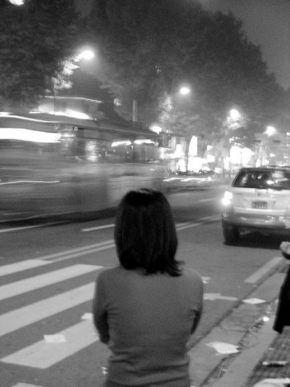Posted on : Nov.23,2006 16:07 KST
Modified on : Nov.25,2006 09:45 KST
 |
|
Kim Sun-i, who has attempted suicide several times, gazes out at a Seoul street.
|
Installing physical barriers main tactic
Thirty three year-old Kim Sun-I - not her real name - quietly laid down for what she intended to be the last time. She pulled out a notebook to write something, but no words came to mind. When sleep came upon her she had one vague thought: "So this is what it’s like to die." Hours later she woke, finding herself on the floor next to a package of rat poison. Leaving four other packages unopened, she rose from her hotel room and made her way into the street as the sun began to rise.
So ended her first suicide attempt, in 1998. She had been seeing her boss at work for two years when his wife telephoned her with "threats, pleading, and cries of desperation." Fortunately her life was spared by an insufficient amount of poison in her system to kill her.
Kim's life has been dominated by the pain of her youth, when she was moved from one relative's house to another to spare her from her father's violence and her parents' neverending fighting. She absorbed herself in work to forget the pain, winning prizes on no less than five separate "advertisement competitions" while attending university. Advertising companies noticed, and she was offered jobs without ever having to jump through hoops like most Korean university graduates.
But after putting in a full day at work, the memories would return. In 1999, she finally went to see a psychiatrist, but that didn't make things any better.
In August of this year, she found herself courting death again. She went to Yeosu, South Jeolla province, intending to go to Odong Island because it would be a quiet place to spend her final moments, but a typhoon was forming and local authorities had blocked access to the island. From there, she went to Busan instead and found a rocky cliff behind a hotel. But a homeless person started yelling at her before she had the chance to jump, and she fled. Her next stop was a bridge near Lake Dongbaek. She climbed the railing, but passers-by grabbed her by the ankles and pulled her back, ending her nightmarish four-day, three-night search for the pefect place to end herself.
Each time it was a person - a guard or a homeless citizen - who just happened to be around at the time and saved her. It was not physical barriers or netting that stopped her, but other humans.
"Suicide is clearly an urge. Even if you think about it all the time, it is in a sudden moment that you actually try," says Kim. "Making human surroundings as 'inconvenient' as possible for suicide, such as by blocking access to rooftops and making higher barriers on bridges and selling over-the-counter pharmaceuticals in smaller amounts would help prevent suicide." When people stop to think about how to deal with obstacles they will run into while trying to take their own lives, Kim says, the urge subsides.
A law prohibiting the sale of pills that can be used in suicide in amounts over sixteen pills was passed in the United Kingdom in 1998, and immediately that country saw a decrease in overdoses, a mere 21 percent of what it had registered the previous year. The Duke Ellington Bridge in Washington D.C. used to be the site of 3.67 suicides a year. But in the five years since a barrier was built along its sides, the average has been one or less.
Similar thinking is taking root in Korea. On Thursday the "Life Rights Campaign" (Saengmyeong Ingwon Undong Bonbu) holds its first meeting open to the public. A new organization, the campaign plans to bring changes to the "social environment" to make it hard for people to have access to bridges, rooftops, and dangerous pharmaceuticals. In the process, they hope to prevent the 10,000 suicides a year, or 34 a suicides a day, that occur in South Korea.
Please direct questions or comments to [englishhani@hani.co.kr]

